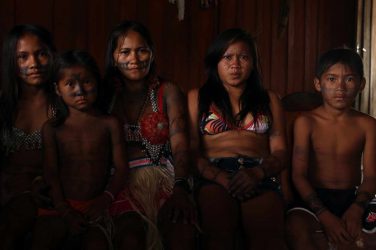
The editors of The Brazil Reader have chosen well. Articles,
which may at first glance seem too specialized, often turn out to be quite riveting and
Brazil under President Getúlio Vargas receives extensive attention.
The Brazil Reader, edited by Robert M. Levine and John J.
Crocitti, Duke University Press, 527 pp., $21.95 paper
“It is Brazil’s singularity—and its character, self-perceptions, and
transitions—that provides the central theme of The Brazil Reader,” we are
told by the book’s editors, who have chosen a diverse and ultimately rich selection of
articles and excerpts about Brazil from scholarly and non-scholarly sources, from diaries,
journals, novels, eyewitness accounts, and even from the Internet. Photographs and art are
interspersed. The result is a kaleidoscopic portrait that provides a peek into virtually
every corner of Brazilian life over the last 500 years.
Semi-chronological, the book is diced into nine categories, the early sections grouping
material related to the colonization and settling of the country, its battles and quest
for independence, as well as the issue of slavery and its aftermath. Considerable space is
devoted to “The Vargas Era,” with later headings focused on Brazil’s regaining
and trying to maintain democracy, the status of women, race relations, socioeconomic
realities, and entertainment.
The editors have chosen well. Articles, which may at first glance seem too specialized,
often turn out to be quite riveting. For example, Stanley J. Stein’s “A Paraíba
Plantation, 1850-1860,” written in 1951, is a vivid portrait of a coffee plantation,
the fazendeiro (landowner) and his fazenda. Another article looks at the
unpopular, exhaustive, Paraguayan War. There’s also a fascinating account by Dain Borges,
“A Mirror of Progress,” on the ill-fated assault of Canudos in the 1890s, which
is the subject of Rebellion in the Backlands (Os Sertões), the famous book by
Euclides da Cunha.
Brazil under Getúlio Vargas, who ruled from 1930-1945, and then from 1950-1954,
receives extensive attention. For a glimpse at how Vargas exerted his power, see Bailey W.
Diffie’s “Comments on the Estado Novo,” and, for another angle, the piece
entitled “Ordinary People: Five Lives Affected by Vargas-Era Reforms,” which
consists of affecting, engrossing, personal reminiscences. Ironically, since he’d been a
dictator himself, Vargas’s surprise suicide in 1954 may have delayed the military
dictatorship (1964-1985) by ten years. The military, it seems, was poised to seize power
towards the end of Vargas’s rule, but relented in the wake of public opinion that,
overnight, shifted from restlessness to sympathy.
As close to Africa as it is to the United States, Brazil has been influenced by African
music to a far greater extent than this country. Some of us listen to King Sunny Adé,
Salif Keita and Baaba Maal, but it doesn’t go much further than that. Salvador, Bahia, on
the other hand, has harbored and nurtured a strong African undercurrent from its earliest
days. Christopher Dunn’s “Tropicalism and Brazilian Popular Music under Military
Rule,” highlighting such musicians as Caetano Veloso and Gilberto Gil, naturally,
should find an audience among those who gravitate and gyrate to world music.
The section devoted to “Women’s Lives” has an appeal that transcends gender,
whether in the account of avant-garde artist Tarsila do Amaral or of Amazonian Indians
mashing manioc into farinha. Under the heading of “Race and Ethnic
Relations” is included some recently discovered manuscript notes for Britita’s
Diary, a book by Carolina Maria de Jesus, better known perhaps for Child of the
Dark, her account of living in shantytown.
We may assume that poor families stick together and look after their own; what we learn
is that this isn’t necessarily true. Another revelation: The late Lester B. Rout, Jr.,
formerly with the Paul Winter Sextet, was a black musician who at one time considered
moving to Brazil from the United States. What he discovered there during the 1960s,
however, made him realize that the country wasn’t colorblind after all, that racial
segregation was lurking just under the surface.
Everyone’s heard of Hector Babenco’s 1981 film, Pixote (at the time of its
release, the third most commercially successful film in Brazil behind Dona Flor and Her
Two Husbands and Bye Bye Brazil), but many people may not have been aware of
the fate of its leading actor—shot to death a few years later by the police at age
19. Robert M. Levine’s account of Pixote star Fernando Ramos da Silva’s short,
tragic life is not only fascinating, but indirectly a scathing commentary on the social
fabric of the time in that it embraces attitudes about race and prejudice, poverty and
social welfare.
Whether ingested in short sips or long draughts, The Brazil Reader has an
accumulative weight, breadth, and durability. Along with Thomas E. Skidmore’s Brazil:
Five Centuries of Change, it’s a book that deserves to be kept in reach. It is, in
fact, hard to imagine how we were able to get along without it.
Bondo Wyszpolski also heads up the arts and entertainment section of the
Easy Reader, a weekly newspaper based in the South Bay of southern California. He
can be reached at bwyszpolski@earthlink.net
EXCERPT
from “Pixote’s Fate,” by Robert M. Levine, in The Brazil
Reader, ed. by Robert M. Levine and John J. Crocitti.
The movie’s national and international success came when Fernando Ramos da Silva was
twelve, a year after the movie was made. Pixote [1981] was seen by an estimated two
and a half million people in twenty countries, mostly in art cinemas… In 1984, he was
arrested on robbery charges in his old neighborhood. After his second arrest, in 1985, he
told a reporter that he wanted the public to forget his image as Pixote. “I want a
chance to live as a man, without being persecuted,” he said. “They created a
Pixote, but they did not know how to prepare him for life.” He pleaded with José
Louzeiro to write a sequel to his romance-reportage in which Pixote would be redeemed. The
request was not considered viable, however. “I pulled him out of this absurd dream,
to wake him up for other projects, but he didn’t seem to believe,” Louzeiro said in
response.
His brothers and sisters said that Fernando felt persecuted by being typecast as Pixote
and wanted to play romantic roles. In 1985, now nineteen with two tattoos on his arms and
a sparse beard, he married a sixteen-year-old girl from a family of migrants from the
interior of Minas Gerais, Cida Venâncio da Silva. Fernando settled down to an ordered
life after the birth of their daughter, Jacqueline. His wife later said that Fernando
always had two personalities: the aggressive and self-sufficient character of Pixote, and
a more emotional, romantic, and sensitive face, which she called the “real
Fernando.” His last job was in the Northeast, where he had been acting in a play, Atalpia
My Love, in the part of a hired assassin.
When he returned to his family, he was playing cards in a neighborhood tenement when he
learned that the military police were conducting raids in the area, looking for criminals.
Fearing that he would be harmed, he fled unarmed to another house. The police found out
about his flight, and although they had no formal charge against him nor any warrant,
pursued him and dragged him out from under a bed where he was hiding. He pleaded with his
captors not to harm him—he was overheard by several residents of the tenement as
saying that he was the father of a small daughter he had to raise—but was shot to
death…
His mother and wife cried to reporters that the shooting had been a police execution.
The body had seven holes in it; two in the right arm, five more in the chest. A forensic
examination revealed that on the basis of the powder marks on his white cotton shirt, the
youth had been shot with the gun nearly touching him while he was lying on the ground, but
the official police report blandly said that he had died while resisting arrest. Police
spokespersons, attempting damage control, rationalized the youth’s violent end by
emphasizing that he was a known bandit and that he used his fame as Pixote to demand
clemency when he was caught. “Every time he was detained,” Mario Miguel Bittar,
the police officer who first arrested him claimed, “[he] promised to straighten out,
and he cried a lot…” What Bittar did not mention was that each time that
Fernando was arrested, the boy had been tortured with electric shocks, and that the police
had treated him all the more roughly than other youths in their custody because of his
fame. Fernando’s death produced an outcry across Brazil, but it quickly subsided…
On one hand, then, the outcry against what had happened suggested that people did care,
that the success of the film Pixote and the publicly expressed sympathy at what had
happened to the film’s baby-faced title actor was a positive sign. But the fact was that
nothing changed. Several of Fernando’s own brothers died violent deaths without public
outcry; they were, of course, unimportant marginals without the aura of film
stardom… Of the seven child actors in Pixote, only the boy who played the
androgynous Lilica, Jorge Julião, briefly succeeded in an acting career. The others fell
back into poverty.
Send
your
comments to
Brazzil







